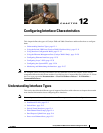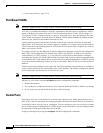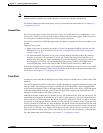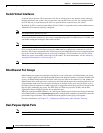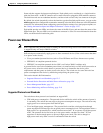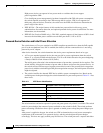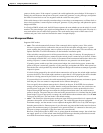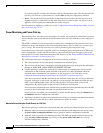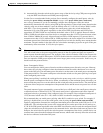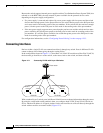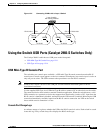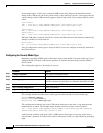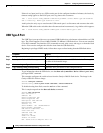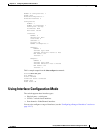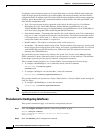
12-9
Catalyst 2960 and 2960-S Switch Software Configuration Guide
OL-8603-09
Chapter 12 Configuring Interface Characteristics
Understanding Interface Types
3. Automatically when the switch sets the power usage of the device by using CDP power negotiation
or by the IEEE classification and LLDP power negotiation.
Use the first or second method in the previous list to manually configure the cutoff-power value by
entering the power inline consumption default wattage or the power inline [auto | static max]
max-wattage command. If you do not manually configure the cutoff-power value, the switch
automatically determines the value by using CDP power negotiation. If the switch cannot determine the
value by using one of these methods, it uses the default value of 15.4 W. On a Catalyst 2960-S switch
with PoE+, if you do not manually configure the cutoff-power value, the switch automatically
determines it by using CDP power negotiation or the device IEEE classification and LLDP power
negotiation. If CDP or LLDP are not enabled, the default value of 30 W is applied. However without
CDP or LLDP, the switch does not allow devices to consume more than 15.4 W of power because values
from 15400 to 30000 mW are only allocated based on CDP or LLDP requests. If a powered device
consumes more than 15.4 W without CDP or LLDP negotiation, the device might be in violation of the
maximum current (Imax) limitation and might experience an Icut fault for drawing more current than the
maximum. The port remains in the fault state for a time before attempting to power on again. If the port
continuously draws more than 15.4 W, the cycle repeats.
Note When a powered device connected to a PoE+ port restarts and sends a CDP or LLDP packet with a power
TLV, the switch locks to the power-negotiation protocol of that first packet and does not respond to
power requests from the other protocol. For example, if the switch is locked to CDP, it does not provide
power to devices that send LLDP requests. If CDP is disabled after the switch has locked on it, the switch
does not respond to LLDP power requests and can no longer power on any accessories. In this case, you
should restart the powered device.
Power Consumption Values
You can configure the initial power allocation and the maximum power allocation on a port. However,
these values are only the configured values that determine when the switch should turn on or turn off
power on the PoE port. The maximum power allocation is not the same as the actual power consumption
of the powered device. The actual cutoff power value that the switch uses for power policing is not equal
to the configured power value.
When power policing is enabled, the switch polices the power usage at the switch port, which is greater
than the power consumption of the device. When you manually set the maximum power allocation, you
must consider the power loss over the cable from the switch port to the powered device. The cutoff power
is the sum of the rated power consumption of the powered device and the worst-case power loss over the
cable.
The actual amount of power consumed by a powered device on a PoE port is the cutoff-power value plus
a calibration factor of 500 mW (0.5 W). The actual cutoff value is approximate and varies from the
configured value by a percentage of the configured value. For example, if the configured cutoff power is
12 W, the actual cutoff-value is 11.4 W, which is 0.05% less than the configured value.
We recommend that you enable power policing when PoE is enabled on your switch. For example, if
policing is disabled and you set the cutoff-power value by using the power inline auto max 6300
interface configuration command, the configured maximum power allocation on the PoE port is 6.3 W
(6300 mW). The switch provides power to the connected devices on the port if the device needs up to
6.3 W. If the CDP-power negotiated value or the IEEE classification value exceeds the configured cutoff
value, the switch does not provide power to the connected device. After the switch turns on power to the
PoE port, the switch does not police the real-time power consumption of the device, and the device can
consume more power than the maximum allocated amount, which could adversely affect the switch and
the devices connected to the other PoE ports.



